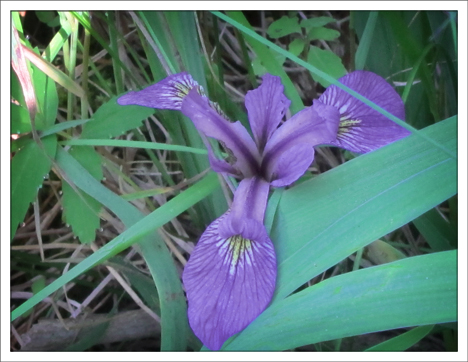Adirondack Wildflowers:
Blue Flag Iris (Iris versicolor)
 Adirondack Wildflowers: Blue Flag Iris blooming on Heron Marsh (14 June 2012)
Adirondack Wildflowers: Blue Flag Iris blooming on Heron Marsh (14 June 2012)
| This page is no longer being updated. For an updated and expanded version of this material, see: Blue Flag (Iris versicolor). |
Blue Flag Iris is a showy native iris of the Adirondacks and other northeastern wetlands. It flowers during late spring and early summer, producing several violet-blue flowers. The down-curved violet sepals are veined in yellow and white. The flowers are 2.5 to 4 inches wide. The plant is 2-3 feet tall with long, narrow leaves (1/2 to 1 inch wide) of bluish green.
This plant is also called Northern Blue Flag, Larger Blue Flag, Harlequin Blueflag, and Wild Iris. The name flag is from the middle English word "flagge," meaning rush or reed. Iris flowers are said to symbolize power, with the three parts representing wisdom, faith and courage.
Blue Flag Iris plants are pollinated by bees and, like other plant species pollinated by bees, have evolved special types of flowers that are easy for bees to find. The Blue Flag Iris has large lobes that bees use as landing platforms and special markings directing bees to the nectar glands.
Blue Flag flourishes in swamps, marshes, and wet shorelines throughout the north woods region. Its distribution includes Canada and the northern part of the US, south to Virginia.
In the past, Blue Flag was a popular medicinal plant among North American Indian tribes. Although Blue Flag Iris is poisonous, Native Americans and colonists dried the rhizome of the plant and used it in small amounts as a cathartic and diuretic. In addition, some North American Indian tribes reportedly used the two outermost fibers of the leaves to spin twine. Powdered iris root has also been added to perfume and potpourri.
 Adirondack Wildflowers: Blue Flag Iris blooming on Heron Marsh (14 June 2012)
Adirondack Wildflowers: Blue Flag Iris blooming on Heron Marsh (14 June 2012)
Blue Flag Iris grows in Heron Marsh at the Paul Smiths VIC, where it usually begins blooming in June.
References:
- Lady Bird Johnson Wildflower Center. Native Plant Database.
- United States Department of Agriculture. Plants Database.
- Plants for a Future. Database.
- Flora of North America. Plant Database.
- Anne McGrath. Wildflowers of the Adirondacks (EarthWords, 2000), pp. 60,89.
- Doug Ladd. North Woods Wildflowers (Falcon Publishing, 2001), p. 47.
- Lawrence Newcomb. Newcomb's Wildflower Guide (Little Brown and Company, 1977), pp. 120-121.
- Roger Tory Peterson and Margaret McKenny. A Field Guide to Wildflowers. Northeastern and North-central North America (Houghton Mifflin Company, 1968) pp. 314-315.
- Donald D. Cox. A Naturalist's Guide to Wetland Plants. An Ecology for Eastern North America (Syracuse University Press, 2002), pp. 53-54.
- William K. Chapman, et al. Wildflowers of New York in Color (Syracuse University Press, 1998), pp. 122-123.
- National
Audubon Society. Field Guide to Wildflowers. Eastern Region.
(Alfred A. Knopf, 2001), pp. 571-572,611.
